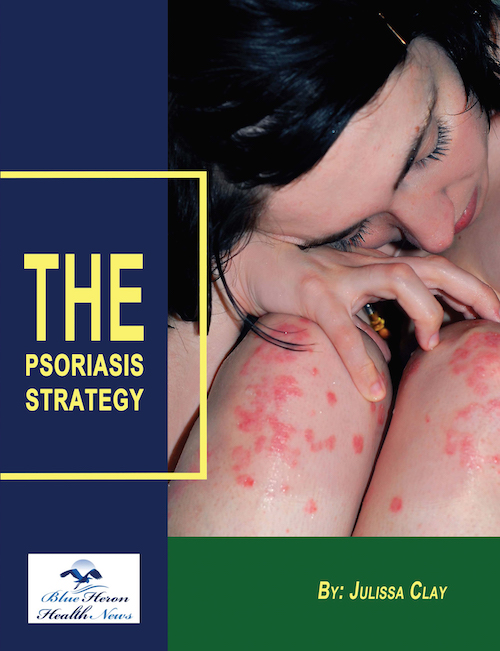
The Psoriasis Strategy™ By Julissa Clay to treat your skin problem of psoriasis The Psoriasis Strategy can be the best option for you as it can help you in curing your skin problem without worsening or harming your skin condition. All the tips provided in this eBook can help you in treating your psoriasis permanently, regardless of the period you are suffering from it.
What are the common symptoms of psoriasis?
Psoriasis is a chronic autoimmune skin condition characterized by rapid skin cell turnover, leading to the buildup of skin cells on the surface. This can result in a variety of symptoms that vary in severity from person to person. Here are the common symptoms of psoriasis:
1. Plaques (Thickened, Red Patches)
- Description: The most common symptom of psoriasis is the development of thickened, red patches of skin covered with silvery-white scales. These patches, known as plaques, are often itchy and sometimes painful.
- Location: Plaques commonly appear on the elbows, knees, scalp, lower back, face, palms, and soles of the feet, but they can occur anywhere on the body.
2. Scaling
- Description: Psoriasis causes an accelerated turnover of skin cells, leading to the buildup of dead skin cells on the surface. This results in scaling, where the skin becomes dry, flaky, and peels off.
- Extent: The extent of scaling can vary, from fine, white flakes on the scalp to large, thick plaques on other parts of the body.
3. Dry, Cracked Skin
- Description: The affected skin may become dry, and cracks can develop, which may sometimes bleed. This is particularly common in areas with thicker plaques.
- Discomfort: Cracked skin can be painful and may increase the risk of secondary infections.
4. Itching and Burning Sensations
- Description: Psoriasis often causes intense itching, which can lead to scratching and further irritation of the skin. Some people also experience a burning or stinging sensation in the affected areas.
- Impact: The itching can be severe and impact daily activities, sleep, and overall quality of life.
5. Pitted or Thickened Nails (Nail Psoriasis)
- Description: Psoriasis can affect the nails, leading to changes such as pitting (small depressions in the nail surface), thickening, discoloration, and separation of the nail from the nail bed (onycholysis).
- Location: Nail psoriasis can affect both fingernails and toenails and is often associated with more severe forms of psoriasis, particularly psoriatic arthritis.
6. Joint Pain and Stiffness (Psoriatic Arthritis)
- Description: Psoriatic arthritis is a form of arthritis that affects some people with psoriasis. It causes joint pain, stiffness, and swelling, which can affect any joint in the body.
- Impact: Symptoms of psoriatic arthritis can range from mild to severe and can lead to joint damage and reduced mobility if not properly managed.
7. Swollen and Stiff Joints
- Description: Psoriatic arthritis can cause swelling and stiffness in the joints, often worse in the morning or after periods of inactivity.
- Joints Affected: The condition commonly affects the fingers, toes, knees, and lower back, but it can impact any joint.
8. Changes in Skin Texture
- Description: The skin in affected areas may become thickened and feel rough to the touch due to the buildup of excess skin cells.
- Lichenification: In some cases, repeated scratching and rubbing can lead to lichenification, where the skin becomes even thicker and leathery.
9. Color Changes in the Affected Areas
- Description: The plaques of psoriasis typically appear red or pink with white or silvery scales. However, in people with darker skin tones, the plaques may appear darker (purple, gray, or brown) and may leave areas of lighter or darker pigmentation after they heal.
10. Fatigue
- Description: Many people with psoriasis, especially those with psoriatic arthritis, experience fatigue. This is partly due to the chronic inflammation associated with the condition and can also be exacerbated by the emotional and physical toll of managing the disease.
11. Soreness and Pain
- Description: The affected areas of the skin, particularly where plaques are thick or cracked, can be sore and painful. This pain can be exacerbated by movement, friction, or pressure on the affected areas.
12. Eye Problems
- Description: In some cases, psoriasis can lead to eye issues, such as conjunctivitis (pink eye), uveitis (inflammation of the middle layer of the eye), or blepharitis (inflammation of the eyelids).
- Symptoms: Symptoms of eye involvement may include redness, pain, irritation, and blurred vision, and they require prompt medical attention.
13. Emotional and Psychological Effects
- Impact on Mental Health: The visible nature of psoriasis, combined with chronic pain and discomfort, can lead to emotional and psychological challenges, including depression, anxiety, and low self-esteem. The impact on mental health is significant and can affect overall well-being and quality of life.
Summary
The symptoms of psoriasis can vary widely but typically include thickened, red plaques covered with silvery scales, dry and cracked skin, itching, burning sensations, and nail changes. In some cases, it can also lead to joint pain and stiffness, particularly in the form of psoriatic arthritis. The condition can have a significant impact on both physical and mental health, making comprehensive management essential for improving quality of life.

The Psoriasis Strategy™ By Julissa Clay to treat your skin problem of psoriasis The Psoriasis Strategy can be the best option for you as it can help you in curing your skin problem without worsening or harming your skin condition. All the tips provided in this eBook can help you in treating your psoriasis permanently, regardless of the period you are suffering from it.